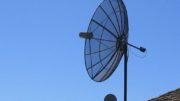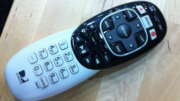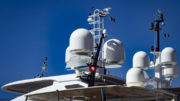Boat owners rejoice: chances are that unless you’re on a long cruise, your satellite receivers will work. There are no hard and fast rules, but generally you will continue to get DIRECTV or DISH satellite TV at least 10 miles offshore.
How satellite TV works
All satellite TV transmissions are, essentially, spot beams. That is to say, they are designed to focus on the area of the planet where they’re needed. Even the widest beams, known as the “CONUS” beams, are designed so that they closely follow the borders of the United States. This is done on purpose. It’s not that they don’t want international customers, it’s that DIRECTV and DISH would need to get licenses for every country they cover. These licenses only cover the United States. Some smaller countries such as Caribbean nations will allow these broadcasts, because basically they can’t stop them anyway. But the “party line” is that DIRECTV and DISH are for US customers only.
However, it’s impossible to tailor the beam so finely that the transmissions “hard stop” right at the border. In practice, spot beams tend to be usable about 10-20 miles further than where they are supposed to stop. You could fix this by narrowing the beam, but then people on the borders and coasts would get weak satellite signal. You realize this is a problem when you look at how many major cities are right on the ocean.
So, the signal goes out into the ocean a bit.
“International waters” don’t even start for 10 miles off shore, and once you’re in them, you’re technically on your own, beholden to no one but the United Nations. Certainly nobody is intentionally putting satellite TV out there and there’s no one to complain if someone does.
You’ll find that DIRECTV satellite service hugs the coast a little more than DISH. This isn’t really intentional, it’s just an accident of where the actual satellites are. DIRECTV has three primary satellite locations over the center of the country. DISH has three locations in the east and three in the west. Because DISH chose not to pursue that prime Mid-American real estate, they end up having twice as many satellite locations just to service the entire country.
However, this actually works better for marine customers because the signals tend to go further out over the water. That’s one reason some marine customers choose DISH over DIRECTV.
But is it “really” a problem?
Unless you’re rocking some serious marine hardware, you’re not sailing from the US to Europe. Even if you’re spending a couple weeks on the boat you’re probably not going to stray more than a few miles off shore. That’s more than enough distance to give you the feeling like you’re the only person in the world. And, from that safe distance, you’ll get to enjoy all the satellite entertainment you want. Sounds like a win-win to me.
If you’re looking to get satellite TV for your boat and you don’t know where to start, give the experts at Signal Connect a call. Signal Connect is the commercial and marine arm of Solid Signal and the experts there will help you figure out exactly what you need. We can help with satellite TV, internet, and even show you how to use cell service farther offshore than you would ever expect. The number is 888-233-7563! We’re here to help you during East Coast business hours. If it’s after hours, no problem! Fill out the form below. Our team will get right back to you!




